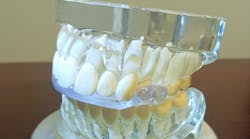When it comes to temporomandibular disorder (TMD) treatment, you have to decide what is science based and what is basically smoke and mirrors. The causes and symptoms of this disorder affects 11 to 12 million adults in the United States, and nearly twice as many women as men.1
Dr. Anthony Urbanek, oral and maxillofacial surgeon and an MD, has spent 30 years researching and interviewing patients to find the root causes and help patients find relief. As a result, he created a device that works for 95% of the patients who follow his protocol.
Dr. Urbanek found that patients suffering from TMD present with a range of symptoms:
- Frequent and recurring headaches
- Neck, upper back, and shoulder pain
- Pain radiating in and around the temporomandibular joint
- Dizziness, ringing and fullness in the ears
These symptoms are caused by inflammation of the temporomandibular joint. After extensive testing, he found that relieving the pressure on that joint eliminated the pain and discomfort even in other parts of the body.
To relieve the pressure on the TMJ, Dr. Urbanek created the Urbanek Device, which fits in the roof of the mouth right behind the upper anteriors. The device, customized for each patient, unloads the joint and relieves inflammation. For about 85% of patients, the device is worn 24/7 for 2 months, and then nighttime only.
Finding out if inflammation of the TMJ is the reason for these pains is relatively easy and quick. Use this checklist:
- Is the patient able to fully open his/her mouth?
- Does the patient feel discomfort if you put some pressure with your finger on the coronoid process and move up towards the joint?
- Does the patient have mandibular tori, palatal tori or maxillary or mandibular exostoses?
- Does the patient feel pain if you do this? Stand beside the patient and ask them to open wide. On the outside of the patient’s face, place your fingers firmly in the depression in front of the ears where the TMJ is located. Press firmly, and ask them to bite as rapidly as they can into occlusion.
While the Urbanek Device seems simple to use, it’s important to use it as directed. To learn the basics about the Urbanek Method and get certified, dentists can take the 2.5-hour online course and take the CE and certification test. Learn more at Urbanek TMJ Device & Protocol.
Dr. Urbanek designed his device after research and interviews with thousands of patients. He is making an impact on the treatment of TMD, and by educating dentists about this condition, continues his mission to improve the quality of life for his patients and yours.
You may also be interested in ... What is an orofacial pain dentist?
Reference
- TMD (temporomandibular disorders). National Institute of Dental and Craniofacial Research. Updated March 2023. https://www.nidcr.nih.gov/health-info/tmd







